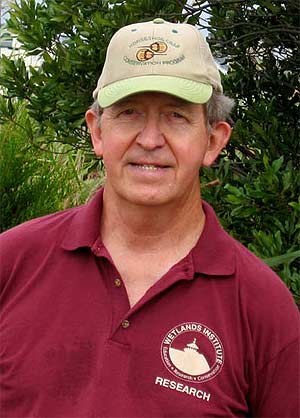 

The New York Turtle and Tortoise Society presents

Seminar 2018

Saturday, April 7, 2018
Check-in 9:30 a.m.; Sessions 10:00 a.m.–5:00 p.m.

Sarah Lawrence College Center for the Urban River at Beczak
35 Alexander Street, Yonkers, New York 10701
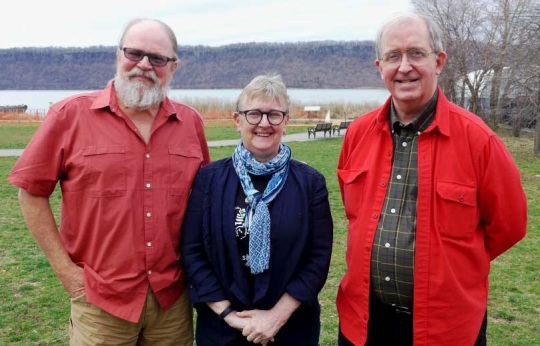
Seminar 2018 speakers: George Heinrich, Bonnie Raphael, and Roger Wood
Photo by Anita Salzberg |
 |
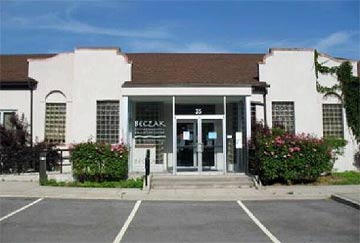
Sarah Lawrence College Center for the Urban River
at Beczak in Yonkers, New York
|
Seminar 2018 was held at the Sarah Lawrence College Center for the Urban River at Beczak in Yonkers, New York. An easy drive up from the city or down from points in Westchester County, there is ample parking is available. It also just two blocks north of the Yonkers Metro North (Hudson River Line) station (see map and train schedules (PDF) (new schedules and fares as of 03/19/2017!).
See Driving Directions to Beczak
|

 Program
Program

 |
 |
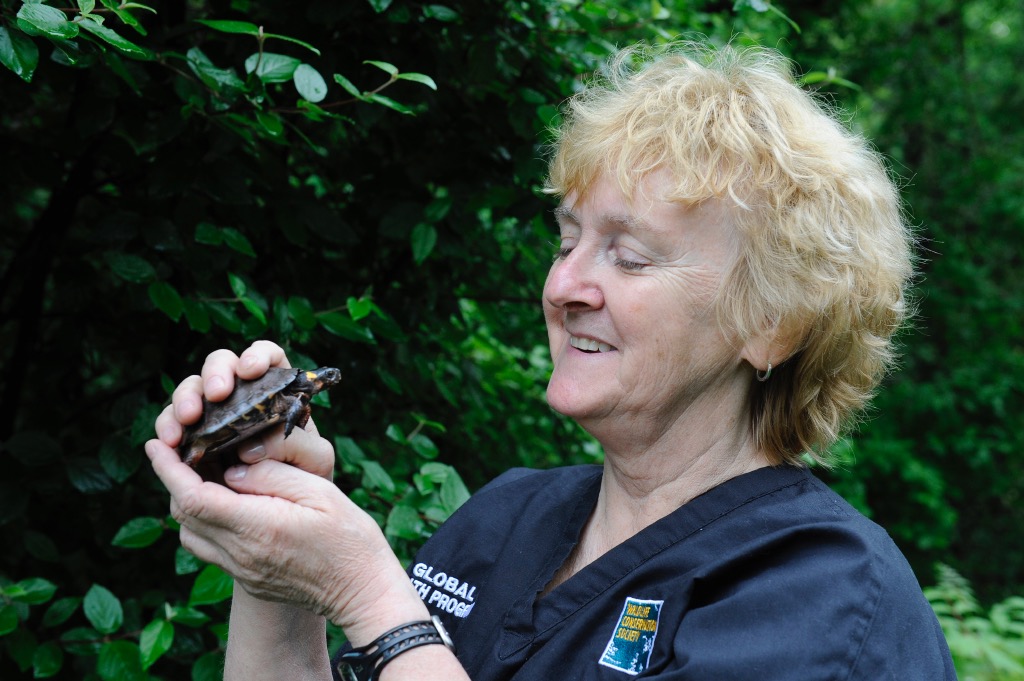

Bonnie Raphael
Photo by Julie Larsen Mahler | |
Bonnie Raphael
Former Department Head for Wildlife Medicine, WCS/Bronx Zoo
 “Health Screening of Bog Turtles in the Northeast”
“Health Screening of Bog Turtles in the Northeast”

Bonnie will discuss health screening of turtles in the field and the implications of documenting underlying pathogens in diverse populations. There will be an emphasis on how this impacts field work,
 |
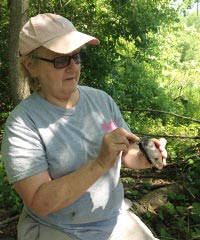
Bonnie Raphael in the field screening bog turtles |
 |
rehabilitation of turtles and what some of the findings mean to both individual turtles and populations. There will also be a presentation of how to use health screening to assure success of reintroduction programs.

Bonnie Raphael is a veterinarian who has spent the last 26 years of her career in the Zoological Medicine Department of the Wildlife Conservation Society/Bronx Zoo. She has experience with wild and captive chelonians in Asia, Africa and North America. She has worked on a variety of taxa, implementing protocols for safe reintroduction of animals to the wild, recently with Burmese star tortoises in Myanmar. Since 2010 she has been working with state agencies and U.S. Fish and Wildlife Service, performing health assessments on bog turtles in all of the Northeastern states where they are found.

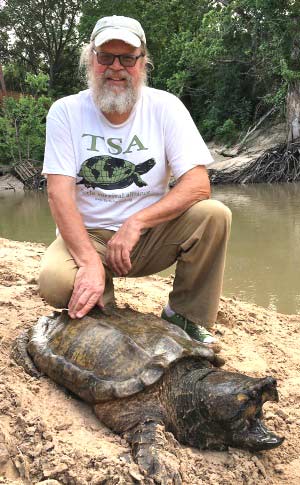

George L. Heinrich with adult male alligator snapping turtle (Macrochelys temminckii; Harris County, Texas). Photo by Jordan Gray |

 George L. Heinrich
George L. Heinrich
Heinrich Ecological Services, Florida Turtle Conservation Trust,
St. Petersburg, Florida
 “The Big Turtle Year:
“The Big Turtle Year:
Celebrating Wild Turtles Across the United States”
Turtles play significant ecological roles and are visible elements in many habitats. Numerous diverse threats to species globally have contributed to approximately 58 percent of all turtles being threatened with extinction. Working in negative synergy, these threats present broad and immediate conservation challenges for the most endangered wildlife taxa in the world. Despite the urgency of the situation, opportunities for conservation are abundant, and the charismatic attraction of turtles makes them an excellent group for education and outreach efforts to enhance ecological, conservation, and environmental awareness.

Sixty-two turtle species occur in the United States and many are of conservation concern. While species from areas such as Asia, South America, and Madagascar often receive the majority of conservation attention, the plight of species within the U.S. quietly goes unnoticed. The goal of The Big Turtle Year is to increase awareness regarding the status of these often overlooked species and to emphasize their rich diversity, natural history, and conservation needs. Throughout 2017, Florida Turtle Conservation Trust researchers visited numerous sites accompanied by other biologists and conservationists in an effort to see as many species as possible during a single year, while examining threats and conservation actions needed. For more information, please visit www.thebigturtleyear.org.

 |

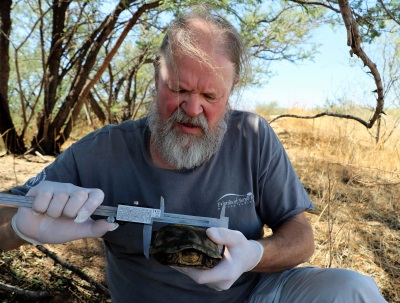
George L. Heinrich taking measurements from an adult male Arizona mud turtle (Kinosternon arizonense) in southern Arizona. Photo by Cristina A. Jones |
George L. Heinrich is a field biologist and environmental educator specializing in Florida reptiles. His company, Heinrich Ecological Services, is based in St. Petersburg, Florida, USA and conducts wildlife surveys and research, natural history programming, and nature-based tours. A graduate of Memphis State University, his current work focuses on the conservation of gopher tortoises (Gopherus polyphemus) at Boyd Hill Nature Preserve (St. Petersburg, Florida), anthropogenic threats to diamondback terrapins (Malaclemys terrapin), and distributional surveys of the Suwannee cooter (Pseudemys concinna suwanniensis) within its southern range. George is an invited member of the IUCN Tortoise and Freshwater Turtle Specialist Group, served twice as co-chair of the Gopher Tortoise Council, and is the executive director of the Florida Turtle Conservation Trust. In June 2009 six NYTTS members joined George’s Florida Turtles Natural History Tour.
Roger C. Wood
Professor Emeritus of Zoology at Stockton University
Former Director of Research at The Wetlands Institute, Cape May, New Jersey
 “The Mysterious Terrapin: Ecology and Conservation Status of the Mangrove Terrapin”
“The Mysterious Terrapin: Ecology and Conservation Status of the Mangrove Terrapin”

A single adult female found in 1906 was the basis for the description of a new subspecies, Malaclemys terrapin rhizophorarum, by its discoverer, H. W. Fowler. As far as we have been able to determine, no subsequent scientific studies of this subspecies were undertaken until 1981.

In January 1981, supported by a great from EARTHWATCH, Roger initiated a still-ongoing field study on a population of mangrove terrapins at the Key West National Wildlife Refuge (KWNWR) in Florida. This is the southernmost population within the range of diamondback terrapins, which extends from Cape Cod, Massachusetts, down the Atlantic coast to the southern tip of the Florida peninsula, and then continues around the Gulf Coast as far west ass Corpus Christi, Texas. Mangrove terrapins have the smallest geographic range of any of the seven described subspecies of Malaclemys and almost certainly have the fewest individuals of any of the subspecies’ populations.

In the course of our study all captured mangrove terrapins have been marked. The cumulative marking over time has enabled the calculation of population size by the Mark, Release, and Recapture method. The adult terrapin population of KWNWR is estimated to number only in the hundreds. However, the size of the population appears to have been stable over the past 30+ years.


Roger Wood is no stranger to NYTTS members, having spoken to our group many times over the years and with whom we worked closely, co-sponsoring the Asian Scholarship Program at the Wetlands Institute from 2000 to 2009, He has distinguished himself not only in his work with diamondback terrapins, but also pancake tortoises (Malacochersus tornieri) in East Africa and the discovery of a new species, the Turkana mud turtle (Pelusios broadlyi) in Lake Turkana in northwest Kenya.

Roger’s work with terrapins is well known: Starting in 1974 he developed long-term studies of terrapins on the Cape May Peninsula as well as the southernmost terrapin population of mangrove terrapins in 1981. In summer 1989 he initiated and developed the Diamondback Terrapin Research and Conservation Program, cosponsored by Stockton State College and the Wetlands Institute.
 |
 |
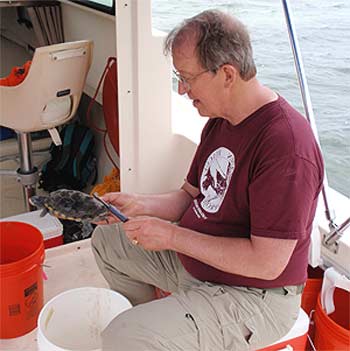
Roger Wood examines a diamondback terrapin.
Photo by Christina Mohrman |
He invented and extensively tested with his students Terrapin Excluder Devices for commercial crab traps, now in wide-spread use and often required by law. He documented the impact of roadkills on diamondback terrapins in southern New Jersey and established a recovery program of retrieving viable eggs from roadkills for incubation, hatching, headstarting, and releasing the juvenile terrapins back into the wild.

But Roger is also a paleontologist: In 1971–1972 he co-taught with colleague Claude Epstein the first-ever college-level course on dinosaurs. In summer 1972 he discovered a giant fossil turtle in Venezuela, which he described and named Stupendemys geographicus, the cast of which now hangs in the Hall of Vertebrate Origins at the American Museum of Natural History. In 1991 he co-authored the first study every published on the evolution of leatherback sea turtles.

Over the 20-plus years he served as Director of Research and Conservation at the Wetlands Institute he mentored more the 200 undergraduates from more than 100 U.S. colleges and universities, as well as the participants in the Asian Scholarship Program. Many of these young people have become scientists or science educators subsequent to their experiences at the Wetlands Institute. |
|
Images from Seminar 2018

Hold mouse over images to pause slide changes.

|

![]()






